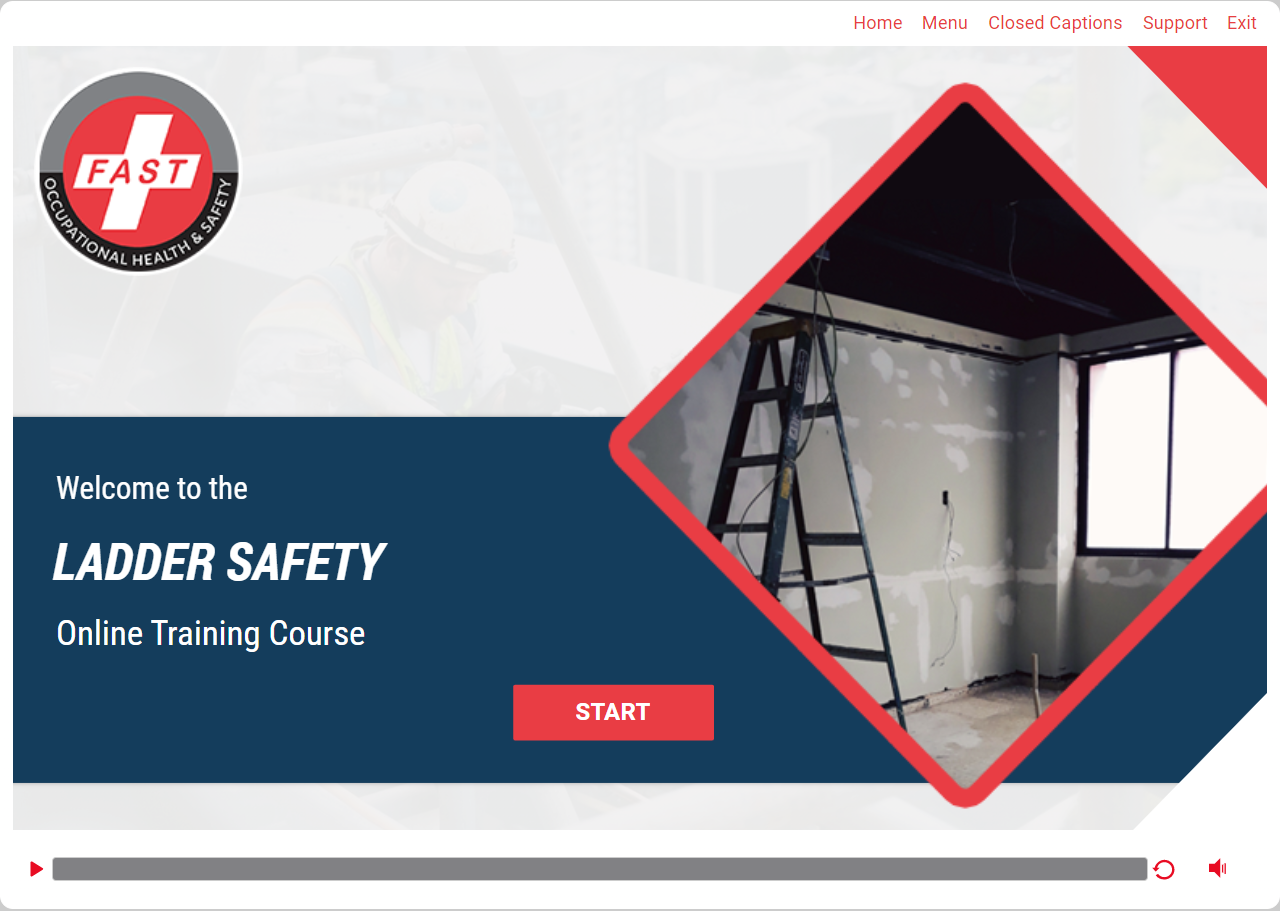
Ladder Safety Online Training Course
(E-SLSG-E)
Introduction to Ladder Safety Online Training Course
Occupational Health and Safety (OHS) – Online Ladder Safety Training and Certification
This training module will help you to understand and interpret the Ladder Safety Program.
This program is designed to give you the knowledge and information about the whys and hows of ladder safety. As an employee you will learn about government legislation, ladder inspection and four types of ladders.
The course adheres to AODA regulations and is fully narrated, providing detailed explanations of each topic, accompanied by relevant visuals and activities to ensure comprehension. A final test is administered at the conclusion of the course to evaluate your understanding.
Moreover, the course can be paused at any time, and it will automatically save your progress, allowing you to resume from where you left off. Additionally, each module culminates in a multiple-choice question (MCQ) test.
LADDER SAFETY TRAINING COURSE OUTLINE
The course covers the following topics:
1. INTRODUCTION
This introductory chapter provides employees with information on the proper use of equipment in the workplace. Also, this chapter suggests to report damaged or defective equipment immediately to management to avoid further damage or harm.
2. LADDER SAFETY LEGISLATION
Ladder safety legislation refers to the set of rules, regulations, and standards established by government bodies or occupational health and safety agencies to ensure the safe use of ladders in various settings. This chapter discusses industrial establishment regulations and provides brief information on how permanent and portable ladders should be constructed.
3. LADDER SAFETY INSPECTIONS
Ladder safety inspections are a crucial component of maintaining a secure work environment and preventing accidents related to ladder use. Ladders must be inspected for defects before and after use. In this chapter, you will learn about ladder inspection and what are the things that need to be taken into consideration while inspecting ladders.
Damaged ladders should be removed from the work area and tagged for repair or replacement, as soon as possible.
When inspecting the ladders, look for:
1. Missing or loose steps or rungs
2. Damaged or worn nonslip feet
3. Loose nails
4. Screws
5. Bolts or nuts
6. Loose or faulty spreaders
7. Locks
8. Other metal parts in poor condition.
4. LADDER TYPES
Ladders come in various types, each designed for specific tasks and settings. Understanding the different ladder types is crucial for choosing the right tool for the job and ensuring safety. There are four main types of ladders that you could have in your business. All types should have nonslip resistant feet and should always be placed on a firm surface. This chapter covers different types of ladders, i.e., portable ladders, step ladders, extension ladders, and fixed access ladders.
The information presented is brief, concise, and accurate, using the right dose of relevant images to provide learners with clarity on each type of ladder.
For example, here are some step ladder safety measures:
1. Ladder should be 1 meter (3 feet) shorter than the highest point you have to reach
2. Open the stepladder spreaders and shelf fully and lock them in place
3. Check stability. Ensure the ladder feet are on a firm level.
4. Place the stepladder at a right angle to the work with either the front or back of the steps facing the work.
Safety guidelines for portable ladders include:
1. Attach a ladder stay across the back of a ladder where a surface cannot stand the load. Extend the stay across a window for firm support against the building walls or window frame.
2. Guard or fence off the area around a ladder erected in an area where persons have access.
5. LADDERS SAFETY TIPS
Using ladders safely is important to prevent accidents and injuries. In this chapter, you will learn about the safety tips while using ladders. The information is presented in the bullet points precisely along with relevant images.
Some of the safety tips include:
1. Maintain three-point contact by keeping two hands and one foot or two feet and one hand on a ladder at all times
2. Face ladder and use both hands to grip the rungs firmly
3. Wear footwear that is in good condition and has a heel
4. Clean muddy or slippery boot soles before mounting ladder
5. Avoid climbing with wet soles
6. Raise or lower tools and materials using a hardlines.
7. Hands should be free of tools or materials while climbing
8. Carry small tools in a tool pouch
6. FINAL TEST
Lastly, at the end of the module, there is a final test in the form of multiple choice questions (MCQs) or choose the correct answer. After going through the module, learners’ have to attempt the final test in order to successfully complete the training.
7. Summary
The module ‘Ladder Safety Training’ focuses on providing required knowledge, awareness, and safety tips on using ladders at the workplace. In this module, an introduction is given followed by legislation and inspection points.
The different types of ladder have been described in different chapters along with relevant images and precise text.
The module is fully comprehensive and informative to the best of learners’ understanding. By the end of the module ‘Ladder Safety Training’, you will be able to understand how to use different types of ladders safely at the workplace.
- Ladder Safety
- Download Certificate
Student Reviews
Feedback from students who have taken this course.

